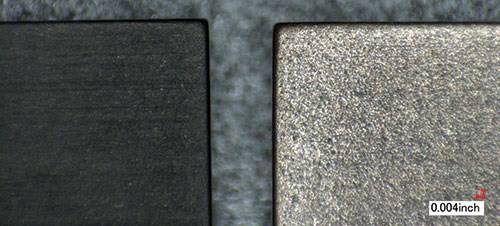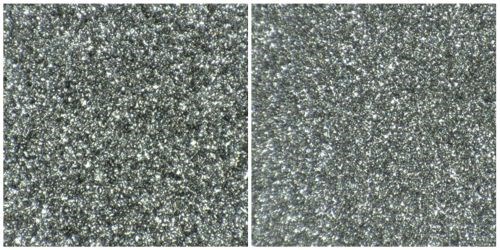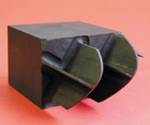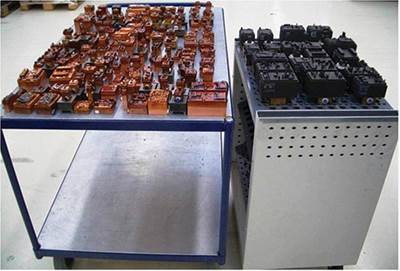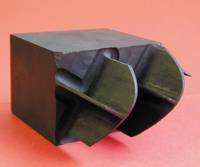Graphite vs. Copper Electrode Material for EDM Applications, Part 2
Test findings and a cost of ownership model help identify the monetary impact graphite and copper electrode materials have on manufacturing.
The previous article on this topic identified the differences between graphite and copper electrode materials, but no definitive data was provided to help determine which material offers better performance. Test results and a cost of ownership model presented here will help identify the impact graphite and copper electrode materials can have on manufacturing costs.
Test Case
The test parameters were to cut identical electrode details to a depth of 1 inch using two electrodes, one for roughing and one for finishing, and then determine if additional electrodes would be required for job completion.
Standard ribs were chosen for simplicity, each measuring 0.040-inch thick by 1-inch wide with a one-degree draft. For time considerations, a final surface finish goal was set at 20 VDI. Two test plates were clamped together with the rib detail EDMed on the center line. This enabled the plates to be separated and the results to be measured on the corresponding halves.
The electrodes chosen for the tests included a graphite electrode in the ultrafine classification and an oxygen-free copper electrode of a grade commonly used in the industry. The tests were conducted on three different sinker EDMs to eliminate any outlying data points. Results from all three tests were averaged together.
Electrode Preparation
Electrodes were purchased on the market with material and machining at the normal rate. The parts were made to print with tolerances reflecting industry standards. Machining procedures were left to the discretion of the company used to manufacture the electrodes. Since the material grade was specifically identified, no substitutions were allowed for either the graphite or copper electrodes. Therefore, the quote that included the lowest cost for each grade was chosen to provide the most economical cost basis for determining the price/performance ratio in these tests.
EDM Programming
The EDM program for each test was generated using the standard technologies for each EDM sinker. For graphite, high-grade graphite versus steel technology was used. A copper versus steel technology was used for the metallic electrodes. In addition, an adaptive control feature was implemented for each test cut to simulate a real-world EDM application.
Since no flush hole could be machined into the electrodes, external flush lines were used with a flush pressure of 3 to 5 psi. No operator intervention, such as tweaking machine parameters, occurred during any of the testing.
Data Collection
Data was gathered from each series of tests to determine the impact of the electrode types on the EDM process. This data included electrode cost, EDM process time, electrode wear for both roughing and finishing, and final sur-
face finish.
Electrode cost. This included the cost of both material and machining, providing an overall electrode price without one component of electrode fabrication carrying a greater value
factor than the other.
EDM time. The time required for each test was taken directly from the time record on each EDM sinker. Time was recorded for each step in the EDM program and then added together to determine the overall EDM time from start to finish. While the time varied significantly from one machine to another, the cost of ownership model is based on the average time of all three EDM tests.
Electrode wear. All electrodes were measured before and after each test to determine the amount of wear during the burn. These measurements were taken with an independent height gage and an end-wear percentage was calculated in relation to the depth of the roughing and finishing cut.
Surface finish. A portable profilometer was used after each burn to measure the surface finish at six locations in each cavity: the top, middle and bottom of the cavity with the workpiece rotated 90 degrees, and from the left, center and right. These measurements were then averaged together to arrive at a final surface finish for the complete burn.
Test Results
Electrode cost. As stated in Part 1 of this article, a copper electrode is often more economical than an ultrafine graphite electrode when only the blank material is taken into consideration. However, when the cost of machining is factored in, the story changes. The cost for each graphite electrode, including machining, was $15.50, while the cost for each copper electrode was $95.
The intention was to use only two electrodes of each material for each test: one roughing and one finishing electrode. Two of the three EDM models used in this test generated programs for two electrodes. However, the graphite program for the third EDM model called for an additional finishing electrode. In this case, a third graphite electrode was used to eliminate operator intervention and bias. This third test will be used to determine the cost basis for electrodes. So the total cost for the graphite electrodes was $46.50 ($15.50 × 3) and for the copper electrodes was $190 ($95 × 2). Both electrode materials are considered to be high-quality choices of each type. Of course, costs could be reduced with more economical electrode materials of lesser quality.
EDM time. All three EDM sinker brands used in this test case programmed the copper electrodes at much higher on-times than their graphite counterparts. This supports Part 1’s assertion that “It takes longer for copper electrodes to break down the gap, reducing metal removal rates.” In all three tests, the graphite electrodes completed the burn at a faster rate than the copper. Depending on the sinker EDM used, the graphite electrodes completed the burns ranging from 28 to 171 percent faster than the copper electrodes. The copper electrodes completed the burn in an average of 4 hours and 29 minutes, whereas the graphite electrode had an average burn time of 1 hour and 54 minutes.
For the purpose of projecting EDM process value, the cost of ownership model described later will use an hourly shop rate of $55.
Electrode wear. To say which electrode material achieved the least amount of electrode wear is difficult, as both materials performed well in their respective category and with the machine technology used. As can been seen in Figure 1, after roughing, the graphite electrode had a larger corner radius than the copper electrode, yet it also had a much smoother edge. The rough edge on the copper electrode will cause the finishing electrode to work much harder to achieve a clean burn depth in the cavity.
After the roughing operation, the copper electrode did show slightly less end wear. However, both materials achieved wear percentages comparable to the electrode detail and machine parameters. Figure 2 shows the opposite result after finishing, with the graphite electrode having reduced corner wear and achieving a cleaner cavity. The corner wear on the copper electrode could have been enhanced with the addition of a third electrode, but this would have increased material costs and burn time.
In total, and not taking corner wear into account, the graphite electrode had an overall wear percentage of 2.75 percent, while the copper electrode achieved an end-wear of 0.42 percent.
Surface finish. Figure 3 shows a 25× magnification of the surface finish in each cavity. As expected, the copper electrode achieved a slightly finer surface finish in the cavity than the graphite electrode. However, neither electrode material met the surface finish goal of 20 VDI. Using the six measurement points described earlier, graphite achieved an average surface finish of 24 VDI, while copper achieved an average surface finish of 22 VDI. Both electrode materials would require a post-polishing process to bring the final surface finish to the required 20 VDI finish.
Estimating $15 per square inch of surface area per VDI point, the cavity produced with the graphite electrodes would incur $60 in polishing costs, while the cavity produced with the copper electrodes would incur $30. (An informal survey of polishing companies established the average polishing cost on a small job.)
Cost Model
A cost of ownership model is useful in determining the overall monetary impact on a production process of using graphite versus copper electrodes. Oftentimes, only electrode material costs are taken into account in EDM operations. This model also considers the cost of EDM, any required post-polishing and the added available throughput on a shop-rate basis.
Table 1 shows the costs associated with each electrode type, broken down by primary EDM factors. This cost of ownership model breaks the costs down by category and then calculates a bottom-line, total effective cost for the entire EDM operation.
Even after factoring in an additional graphite electrode and a slightly higher post-polishing cost, there is a clear and distinct difference between the total cost of production using graphite versus copper, without taking increased throughput into account. The costs associated with the graphite electrodes totaled $211, while the costs associated with the copper electrodes totaled $466.95. If we were to take into account the added throughput (or extra EDM hours available due to faster burn time), a “credit” would be applied to the production costs as a result of the electrode material’s performance. With this applied credit, the total effective cost for the graphite electrodes is reduced to $68.90, while the cost for the copper electrodes remains the same at $466.95.
Evaluating Results
There are myriad of variables that could influence these tests, but the intent was to reduce these variables as much as possible and provide relatively equitable results. It is up to you to use these results and testing of your own to determine which electrode material offers you the most cost-effective operations.
In the end, one thing is certain: In this industry we don’t sell molds, we sell time, and time is money. All too often, only one cost factor is considered and then serves as the basis for decision-making. A better approach is to consider all the factors outlined here together to determine the total effective cost and therefore the appropriate electrode material.
Related Content
Hands-on Workshop Teaches Mold Maintenance Process
Intensive workshop teaches the process of mold maintenance to help put an end to the firefighting culture of many toolrooms.
Read MoreHow to Eliminate Chatter
Here are techniques commonly used to combat chatter and guidelines to establish a foundation for optimizing the moldmaking process.
Read MoreIt Starts With the Part: A Plastic Part Checklist Ensures Good Mold Design
All successful mold build projects start with examining the part to be molded to ensure it is moldable and will meet the customers' production objectives.
Read More6 Ways to Optimize High-Feed Milling
High-feed milling can significantly outweigh potential reliability challenges. Consider these six strategies in order to make high-feed milling successful for your business.
Read MoreRead Next
Graphite vs. Copper Electrode Material for EDM Applications, Part 1
If you’ve been torn in the long-standing, unresolved debate over whether graphite or copper is a better EDM electrode material, here are some considerations identifying differences in cost, detail and performance to help you select the appropriate material for EDM applications.
Read MoreAdvantages and Disadvantages of Copper and Graphite Electrodes
Both copper and graphite provide approximately the same end result, so it is important for a shop to consider the advantages and disadvantages of each material in order to discover what would work best in their shop floor environment.
Read More

